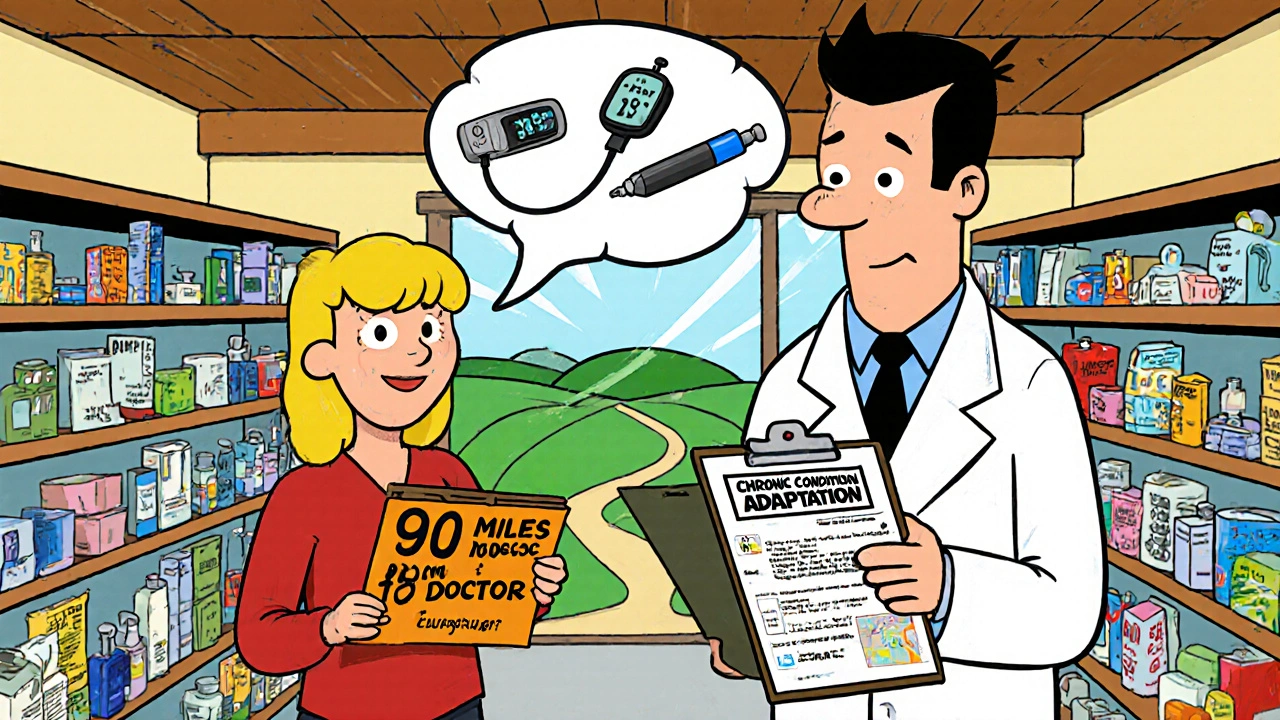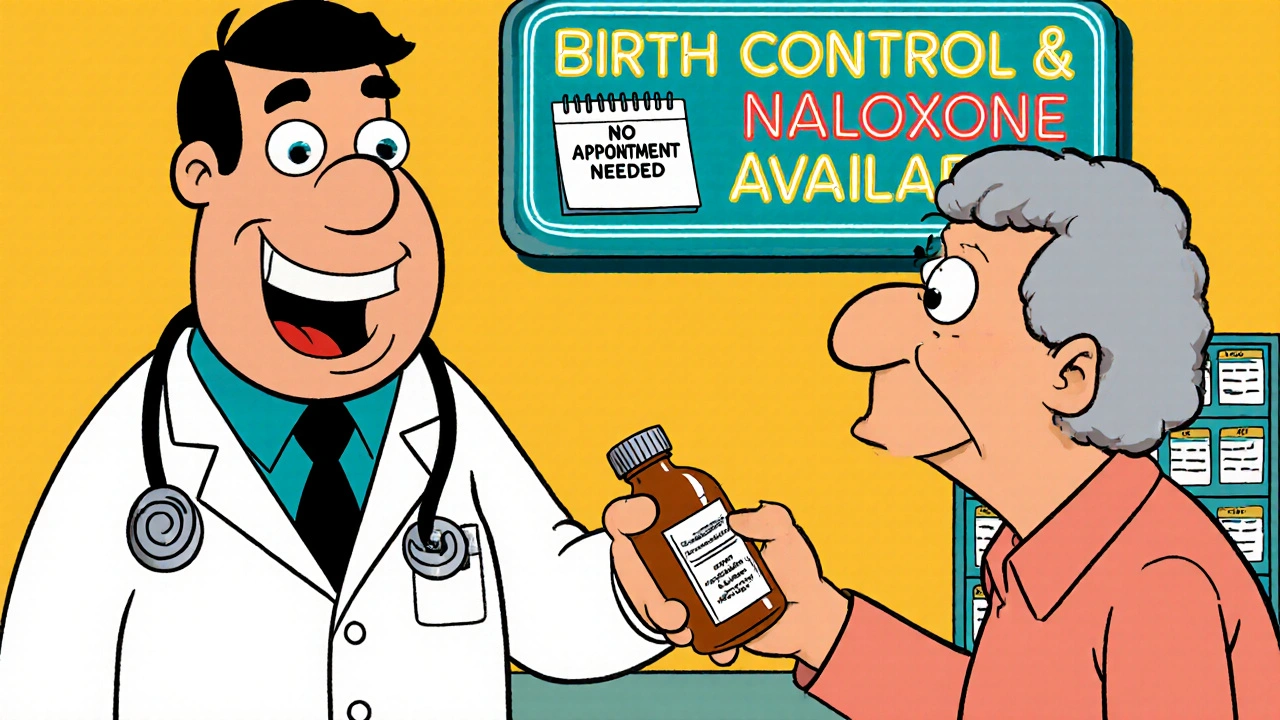For decades, pharmacists were seen as the people who handed out prescriptions. But today, in many parts of the U.S., they’re doing far more-adjusting doses, switching medications, even prescribing birth control or naloxone without waiting for a doctor’s note. This shift isn’t accidental. It’s the result of state laws slowly expanding what pharmacists are legally allowed to do, driven by real needs: rural communities without doctors, patients skipping meds because they can’t get an appointment, and a growing shortage of primary care providers. If you’ve ever wondered why your pharmacist asked if you wanted a different pill, or why your insurance now covers a shot you got at the pharmacy, this is why.
What Exactly Is Pharmacist Substitution Authority?
Pharmacist substitution authority means the legal right to change a prescription in some way-without calling the doctor first. It’s not about making up new drugs or ignoring safety rules. It’s about using clinical judgment within clearly defined limits. There are different levels of this authority, and they vary wildly from state to state.The most basic form is generic substitution. This is allowed in every state. If a doctor writes a prescription for, say, Lipitor, and a generic version of atorvastatin is available and approved by the FDA, the pharmacist can swap it unless the doctor specifically wrote “dispense as written.” It’s a cost-saving move that’s been standard for years.
But things get more complex with therapeutic interchange. This is when a pharmacist swaps a drug for another in the same class-not just a generic version, but a different brand or type. For example, switching from one statin to another because the patient can’t afford the original, or because the new one has fewer side effects. Only three states-Arkansas, Idaho, and Kentucky-have laws that let pharmacists do this independently. Even there, it’s not automatic. The prescriber must write something like “therapeutic substitution allowed” on the script. The pharmacist then has to notify the doctor and make sure the patient understands the change. In Idaho, they must get the patient’s consent out loud. No guessing. No assumptions.
Prescription Adaptation and Collaborative Practice Agreements
Then there’s prescription adaptation. This lets pharmacists tweak an existing prescription-change the dose, switch the frequency, or even renew it-without the original prescriber being involved. This is huge for people in rural areas. Imagine someone with high blood pressure who lives 90 miles from the nearest clinic. They run out of pills. Instead of driving three hours just to get a refill, their pharmacist can adjust the prescription based on a pre-approved protocol. States like New Mexico and Colorado use this model to let pharmacists manage chronic conditions like diabetes or asthma under statewide guidelines.Collaborative Practice Agreements (CPAs) are another key tool. These are formal, written contracts between a pharmacist and one or more physicians. They spell out exactly what the pharmacist can do: order lab tests, start or stop certain drugs, adjust insulin doses, or even treat strep throat. CPAs exist in all 50 states and D.C., but their strength varies. In some places, the doctor still calls the shots. In others, the pharmacist runs the show as long as they follow the protocol. Recent trends show a clear move toward giving pharmacists more autonomy within these agreements-less oversight, more responsibility.
State-by-State Differences: Who Can Prescribe What?
The patchwork of laws makes this confusing. Here’s how some states are pushing boundaries:- Maryland: Pharmacists can prescribe birth control to anyone 18 and older. Medicaid must pay for it.
- Maine: Pharmacists can hand out nicotine patches and gum without a prescription.
- California: They use the word “furnish” instead of “prescribe,” but it means the same thing-pharmacists can give out certain drugs under standing orders.
- New Mexico and Colorado: State pharmacy boards create protocols that let pharmacists treat conditions like flu, UTIs, or allergies without needing a new law for each drug.
Some states even let pharmacists prescribe emergency contraception, opioid overdose reversal kits, or travel vaccines. The trend is clear: pharmacists are being given tools to handle common, low-risk conditions that don’t need a doctor’s visit.

Why the Push for Expansion?
It’s not about pharmacists wanting more power. It’s about patients needing better access.The Health Resources and Services Administration says 60 million Americans live in areas with too few primary care providers. In many rural towns, the nearest doctor might be hours away. Pharmacies? They’re on every corner. Pharmacists are already the most accessible health professionals. They’re there when clinics are closed. They’re there on weekends. They’re there without an appointment.
Meanwhile, the Association of American Medical Colleges predicts a shortage of 124,000 doctors by 2034. Pharmacists-over 300,000 strong-are already trained in medication safety, drug interactions, and patient counseling. Why not use them?
Studies show that when pharmacists manage blood pressure, diabetes, or cholesterol, patients do better. Their numbers improve. Hospital visits drop. Costs go down. That’s not theory. It’s data from real clinics and community pharmacies.
What’s Holding Back Wider Adoption?
The biggest roadblock isn’t training. It’s money.Even in states where pharmacists can prescribe, insurance companies often don’t recognize them as providers. There’s no standard billing code. No clear reimbursement rate. So if a pharmacist gives you a flu shot or adjusts your blood pressure meds, the pharmacy might not get paid. That makes it hard to justify the time and liability.
Another issue is confusion over roles. The American Medical Association has expressed concern that pharmacists don’t have the same level of training as physicians. While that’s technically true, it misses the point. Pharmacists aren’t being asked to diagnose cancer or perform surgery. They’re being asked to manage stable, well-defined conditions-exactly the kind of care that doesn’t require a specialist.
Corporate pharmacy chains have pushed hard for these changes. Independent pharmacists, meanwhile, worry about being turned into factory workers. The real win? When pharmacists can work as part of a team-not replacing doctors, but filling the gaps between visits.
What’s Next? The Federal Push
The biggest game-changer might be federal legislation. The Ensuring Community Access to Pharmacist Services Act (ECAPS) is currently pending in Congress. If passed, it would require Medicare Part B to pay for services pharmacists provide-like screenings, vaccinations, and chronic disease management. That would set a national standard. Private insurers would likely follow.Right now, 211 bills to expand pharmacist scope were introduced in 44 states during the 2025 legislative session. Sixteen of them passed. That’s more than any year before. The momentum is real.
What’s next? More states will likely adopt statewide protocols like New Mexico and Colorado. More pharmacists will be authorized to test and treat. More patients will get care without waiting weeks for an appointment. The role of the pharmacist is no longer just about counting pills. It’s about managing health.
What This Means for You
If you’re a patient: know your pharmacist can do more than fill scripts. Ask if they can help with your blood pressure, your diabetes, or your birth control. They might be able to help right then and there.If you’re a pharmacist: stay updated. Your scope is changing fast. Take advantage of training programs, join your state’s pharmacy association, and understand your legal limits. The rules are different everywhere.
If you’re a provider: this isn’t a threat. It’s a partnership. Pharmacists can handle routine medication issues, freeing you up for complex cases. Work with them. Use CPAs. Share records. Better outcomes come from teamwork-not turf wars.
The system is changing. The question isn’t whether pharmacists should have more authority. It’s how fast we can make sure every patient can benefit from it.
Can a pharmacist change my prescription without asking my doctor?
Only in specific cases and only if state law allows it. For generic substitutions, yes-unless your doctor wrote "dispense as written." For therapeutic interchange or dose changes, it depends on your state. Some states require the prescriber to sign off in advance. Others allow pharmacists to make changes under a collaborative agreement. Always ask your pharmacist what they’re allowed to do.
Do pharmacists need extra training to prescribe medications?
Yes. Most states require additional certification or training beyond the standard Pharm.D. degree. This often includes clinical pharmacology, diagnostic testing, and protocols for managing specific conditions like hypertension or diabetes. Some states also require continuing education credits in prescribing. The level of training varies, but it’s always more than just dispensing.
Can I go to a pharmacy and get antibiotics without seeing a doctor?
In most states, no. Antibiotics still require a prescription. But in a few states like California, Oregon, and Minnesota, pharmacists can prescribe antibiotics for specific conditions like urinary tract infections under standing orders. These are tightly controlled, with protocols that include lab tests and follow-up requirements. It’s not a free-for-all.
Why do some states allow pharmacists to prescribe birth control but not other drugs?
Birth control is a low-risk, high-impact service. It’s well-studied, has clear guidelines, and improves health equity-especially for people who can’t easily access gynecologists. States chose it first because the benefits are clear and the risks are low. Other drugs, like antibiotics or blood pressure meds, involve more complexity and potential side effects, so they’re being added more slowly.
Will my insurance cover services from a pharmacist?
It depends. If you’re on Medicare and the service is covered under ECAPS (if passed), yes. If you’re on private insurance, it’s hit or miss. Many insurers still don’t have billing codes for pharmacist services. Some cover immunizations and screenings. Few cover medication management. Ask your insurer. Push for change. Coverage will follow legislation.
What’s the difference between a CPA and a standing order?
A Collaborative Practice Agreement (CPA) is a written contract between a pharmacist and one or more physicians. It outlines exactly what the pharmacist can do, under what conditions, and when to refer. A standing order is a statewide rule-like a blanket permission from the pharmacy board-that lets pharmacists provide certain services without needing individual doctor approval. CPAs are personalized. Standing orders are system-wide.
Can pharmacists refuse to fill a prescription?
Yes, but only under limited circumstances. Pharmacists can refuse if the prescription is invalid, fraudulent, or potentially harmful. They cannot refuse based on personal beliefs if the prescription is legal and medically appropriate. Some states have "conscience clause" laws that allow refusals for religious reasons, but those are being challenged in court. The trend is moving toward requiring pharmacists to refer patients to someone who can fill the script.
What to Do Next
If you’re a patient: talk to your pharmacist. Ask what services they offer. Don’t assume they can’t help. They might be able to refill your meds, test your blood sugar, or give you a flu shot-all without leaving the store.If you’re a healthcare provider: reach out to local pharmacists. Set up a CPA. Share patient records. You’ll save time, reduce errors, and improve outcomes.
If you’re a pharmacist: stay informed. Join your state pharmacy association. Take the training. Advocate for fair reimbursement. Your role is expanding-and the system needs you to step into it.
The future of healthcare isn’t just about doctors and hospitals. It’s about teams. And pharmacists are no longer just on the sidelines. They’re in the game.

 Thyroid Medications: Levothyroxine Safety and Monitoring
Thyroid Medications: Levothyroxine Safety and Monitoring
 Exploring the Top 8 Alternatives to Canadapharmacy.com in 2025: Navigating the Online Pharmacy Landscape
Exploring the Top 8 Alternatives to Canadapharmacy.com in 2025: Navigating the Online Pharmacy Landscape
 Drug-Disease Interactions: How Your Health Conditions Can Change How Medications Work
Drug-Disease Interactions: How Your Health Conditions Can Change How Medications Work
 How to Manage Medication Refills During Extended Travel
How to Manage Medication Refills During Extended Travel
 Celiac Disease in Children: Growth, Testing, and Diet Adherence
Celiac Disease in Children: Growth, Testing, and Diet Adherence
Henrik Stacke
November 23, 2025 AT 04:02As someone who’s lived in both the UK and the US, I’ve seen how pharmacists here are treated like glorified cashiers - and it’s frustrating. In London, your pharmacist can adjust your statin dose, renew your hypertension script, and even give you a travel vaccine without a doctor’s note. The US is catching up, but slowly. It’s not about overstepping; it’s about using trained professionals where they’re most accessible. Why make someone drive two hours when the pharmacy is five minutes away?
Also, the lack of reimbursement is absurd. If a pharmacist saves you a hospital visit by managing your diabetes, why isn’t that billed like a primary care visit? The system is broken, not the pharmacists.
Manjistha Roy
November 24, 2025 AT 03:20India has a similar issue, but reversed: pharmacists often prescribe without any training, and patients expect it. No protocols. No oversight. Just hand over the money and get the pills. What the U.S. is doing - structured, state-regulated, evidence-based expansion - is the exact opposite of what we need to avoid. This isn’t about power. It’s about safety. Proper training, clear boundaries, and accountability. That’s what matters. I hope the U.S. keeps this model. It’s the right way to do it.
Jennifer Skolney
November 24, 2025 AT 03:56I work at a pharmacy in rural Colorado and this article made me cry 😭. Last week, a 72-year-old woman came in with no insulin. Her doctor was 80 miles away, and she hadn’t been able to get an appointment in three weeks. We used our state protocol to refill her script, checked her glucose, and called her son to make sure she’d get follow-up care. She hugged me. No one else in her town could’ve done that. This isn’t just policy - it’s life-saving. Thank you for writing this.
JD Mette
November 26, 2025 AT 01:28It’s good to see pharmacists being recognized for their clinical skills. I’ve had pharmacists catch errors in my prescriptions that my doctor missed. They’re often the last line of defense. But I also worry about consistency. Not every pharmacist has the same level of training or confidence. State protocols help, but without nationwide standards, patients in some areas get better care than others. It’s a step forward, but not a finished product.
Olanrewaju Jeph
November 26, 2025 AT 21:46The expansion of pharmacist authority is not merely a logistical adjustment; it is a paradigmatic shift in healthcare delivery. Pharmacists, possessing doctoral-level training in pharmacotherapy, are uniquely positioned to assume responsibility for chronic disease management. The reluctance of insurers to reimburse these services reflects systemic inertia rather than clinical justification. Furthermore, the American Medical Association’s resistance is rooted in professional territorialism, not evidence-based concern. Data consistently demonstrates improved outcomes when pharmacists are integrated into primary care teams. The future belongs to interdisciplinary models - not siloed hierarchies.
Dalton Adams
November 28, 2025 AT 02:51Look, I’ve got a Pharm.D. and I’ve worked in 12 states. Most pharmacists don’t know the difference between a beta-blocker and a calcium channel blocker. You think they’re qualified to prescribe? Please. I’ve seen them give out antibiotics for UTIs without checking for allergies or renal function. This isn’t ‘expansion’ - it’s a liability waiting to happen. And don’t get me started on ‘standing orders.’ That’s just lazy medicine. If you can’t get to a doctor, you shouldn’t be getting prescriptions from a guy behind a counter who’s counting pills at 2 a.m. 😒
Also, the ECAPS bill? It’s going to bankrupt Medicare. You think a pharmacist can manage a diabetic’s insulin like a cardiologist? Wake up.
Kane Ren
November 28, 2025 AT 12:42This is the future, and it’s beautiful. Imagine a world where you can walk into a pharmacy, get your blood pressure checked, have your meds adjusted, and walk out with a new prescription - all in 20 minutes. No waiting. No copay drama. No 6-week waitlist. Pharmacists are the unsung heroes of healthcare. They’re the ones who remember your name, your allergies, and that you hate taking pills with food. Let them do their job. We’re not replacing doctors - we’re empowering communities. Keep pushing, pharmacists. The system is finally waking up.
Charmaine Barcelon
November 29, 2025 AT 05:59Oh my gosh, this is so dangerous. I’ve seen people get the wrong meds because the pharmacist ‘thought’ it was fine. You can’t just let someone who counts pills decide what you take. What if they’re tired? What if they’re distracted? What if they don’t know the drug interaction? This is not a ‘service’ - it’s a gamble with people’s lives. And don’t tell me about ‘protocols.’ Protocols don’t care if you’re 80 and on 12 medications. I’m not saying pharmacists aren’t smart - I’m saying they’re not doctors. Period. End of story. 😤
Karla Morales
November 29, 2025 AT 12:45Let’s be real: this isn’t about patient care. It’s about corporate pharmacy chains maximizing profit margins. CVS, Walgreens, Rite Aid - they don’t care if you get your blood pressure managed. They care that you’re buying snacks, toothpaste, and cough syrup while you’re there. Pharmacists are being turned into salespeople with clinical training. And now they want to prescribe? Great. Let them bill Medicare. But don’t pretend this is altruistic. The real win? Lower staffing costs. Higher foot traffic. More revenue. 🤑
Also, the ‘collaborative agreements’? Most are just rubber-stamped by doctors who don’t even know what’s happening. This isn’t innovation. It’s corporate exploitation dressed up as progress.
Javier Rain
November 29, 2025 AT 14:31I’ve been a pharmacist for 18 years. I’ve seen the shift from counting pills to managing care. And I’m telling you - this is the most exciting time in our profession. We’re not replacing doctors. We’re complementing them. In my clinic, we’ve reduced ER visits for asthma by 40% just by letting pharmacists adjust inhalers under protocol. Patients are happier. Doctors are less burned out. Insurance? We’re fighting for billing codes. But we’re winning. And if you think this is risky, go talk to the patients who used to skip meds because they couldn’t get in to see a doctor. They’re alive today because we stepped up. Let’s keep going.
Laurie Sala
November 30, 2025 AT 08:31I’m so tired of people saying pharmacists are ‘just’ pharmacists. My mom had a stroke because the pharmacy didn’t catch the interaction between her blood thinner and the new antibiotic. She’s fine now, but it was a nightmare. And now you want to give them more power? Without oversight? I’m sorry, but I’ve seen too much. This isn’t progress - it’s negligence wrapped in a white coat. Someone needs to stop this before someone dies because a pharmacist ‘thought’ it was okay.
Lisa Detanna
November 30, 2025 AT 22:06As someone who grew up in a rural town with no doctor for 50 miles, I can say this changed my life. When I was pregnant, I got my birth control from the pharmacy. No appointment. No shame. No waiting. That’s dignity. That’s access. This isn’t about taking away from doctors - it’s about giving patients a choice. And if you’re worried about safety, look at the data: pharmacist-managed care has lower error rates than some primary care offices. Let’s stop fearing change and start celebrating equity. Pharmacists are part of the team. And we need them.